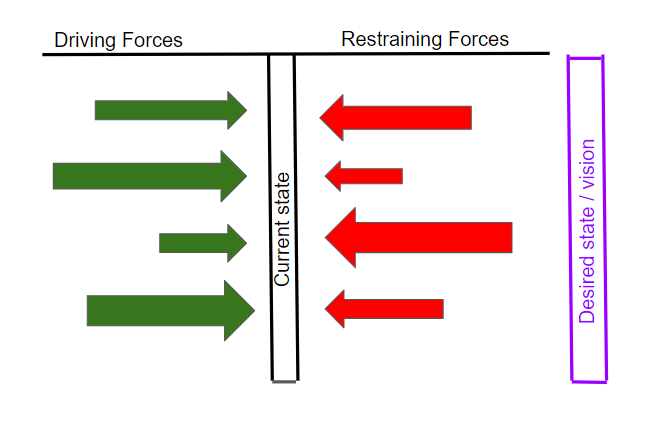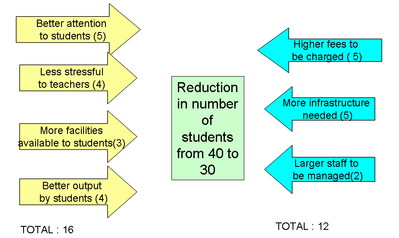
Whether you’re trying to make a change as an individual, or trying to lead a team or organisation through a change, you want to know what you’re up against. You want to know how easy or difficult it’s going to be, and how you can put the odds in favour of making the change.
There are a couple of tools that may be helpful here. The first is Force Field Analysis, which developed from Kurt Lewin’s work in the 1940s and ‘50s.
Lewin posited that our current situation (the status quo) is maintained by the forces acting on us, and any change in our behaviour stems from changes in these forces. Our environment is constantly changing, so the forces acting on us are constantly changing and we adapt.
Lewin suggested that if you could establish what these forces were, you could understand what forces needed to be diminished or strengthened to bring about change.

So a force field analysis is a way of visually representing the forces that support or act as obstacles to any proposed change.
Here’s what to do:
- Identify the change you’re proposing. Then,
- Brainstorm/list all forces that are pushing for the change (the driving forces) or preventing the change (the restraining forces)
- Draw a diagram like the one above. On the left side side list the driving forces, on the right the restraining forces.
- Consider the strength of each of the forces. You can either represent this visually, by drawing larger or smaller arrows (as above). Or another way is to give each force a value from 1 (low) to 5 (high)
- Look at the balance for each side. If using scores, add up the score for each side to get a total.
You should have something like this:

If the forces for change are higher than the forces against the change, you are likely to be successful in making the change. The change above looks likely to succeed, as 16>12. However, if the forces against are higher, you’re likely to struggle.
So this tool is often used for decision making – is it worth trying to make the change at all? Are the forces against too strong to make the attempt?
Now comes the important part.
Brainstorm how you can either increase the driving forces, or decrease the restraining forces, so you have a better chance of the change being successful. (NB Focus on reducing the restraining forces. If you increase the driving forces, the restraining forces may also increase, thereby maintaining the equilibrium. The more you push someone to do something, the more they may resist!)
Now you have some practical actions to take before you make the change, to give you a better chance of making the change successfully.
So this is a handy tool before you start on any change journey to help you see the forces acting on you, and to give you ideas on how to push the odds in favour of the change. You’ve probably noticed that it’s not particularly scientific. Unless you’ve done some market research, you’re relying on brainstorming and guesswork. That said, like any tool, it makes you stop, think and plan, and for teams it helps stimulate discussion.
Give it a try when you’re next planning to make a change, and see what you think.